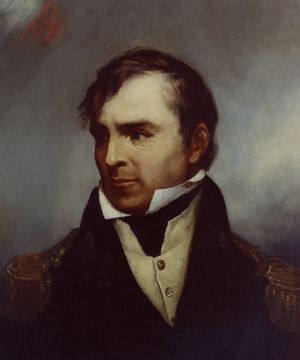

Naval History & Heritage Command photo KN 10910.
Commodore Charles Morris by Sarah E. Smith after Art Scheffer.
Born at Woodstock, Connecticut, in 1784, he joined the Navy at the age of 15, during the Quasi-War with France.
During the Barbary Wars in 1804, in bomb ketch Intrepid under Lt. Stephen Decatur, he participated the raid to burn the former US frigate Philadelphia, which had been stranded and captured at Tripoli.
During the War of 1812, as first lieutenant in Constitution under Capt. Isaac Hull, it was he that suggested kedging to escape a five-ship British squadron chasing her off New Jersey. A month later, Constitution defeated HMS Guerriere off Boston.
Promoted commodore, Morris twice served in the South Atlantic, flying his flag in frigate Constellation in 1819–20 and ship-of-the-line Delaware in 1841–44. He also served in many key posts—Navy Commissioner from 1823 to 1827; Chief of the Bureau of Construction Equipment and Repairs from 1844 to 1847; and Chief of the Bureau of Ordnance and Hydrography (with responsibility for the then-new Naval Academy) in the 1850s.
He died in 1856.
In 1880—eighteen years before the official start of its book-publishing program—the Naval Institute published his autobiography as an issue of Proceedings magazine. It is now available again.